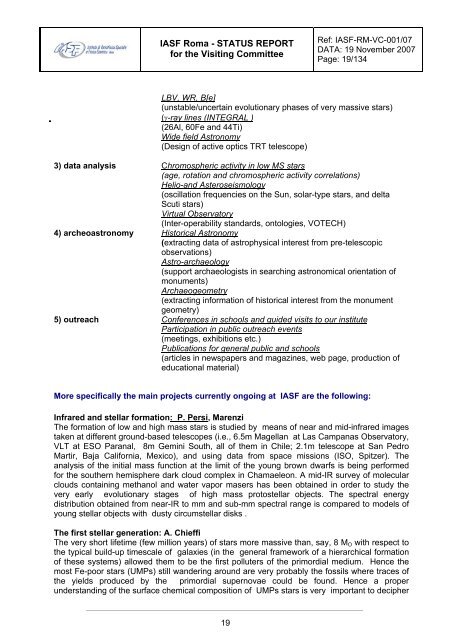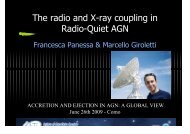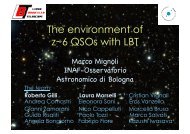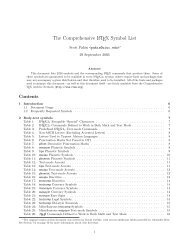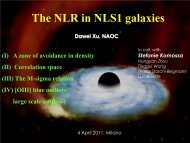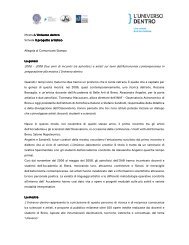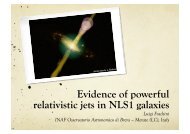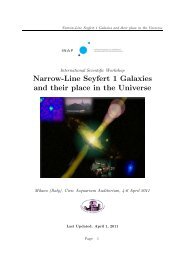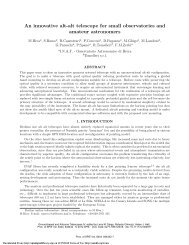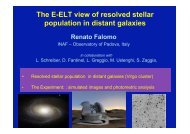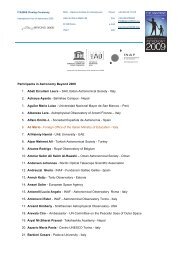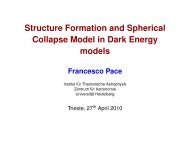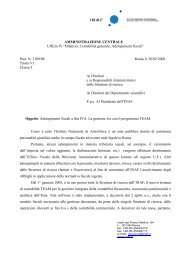IASFRome_StatusReport - INAF-IASF-Roma
IASFRome_StatusReport - INAF-IASF-Roma
IASFRome_StatusReport - INAF-IASF-Roma
You also want an ePaper? Increase the reach of your titles
YUMPU automatically turns print PDFs into web optimized ePapers that Google loves.
<strong>IASF</strong> <strong>Roma</strong> - STATUS REPORTfor the Visiting CommitteeRef: <strong>IASF</strong>-RM-VC-001/07DATA: 19 November 2007Page: 19/134LBV, WR, B[e](unstable/uncertain evolutionary phases of very massive stars) (γ-ray lines (INTEGRAL )(26Al, 60Fe and 44Ti)Wide field Astronomy(Design of active optics TRT telescope)3) data analysis Chromospheric activity in low MS stars(age, rotation and chromospheric activity correlations)Helio-and Asteroseismology(oscillation frequencies on the Sun, solar-type stars, and deltaScuti stars)Virtual Observatory(Inter-operability standards, ontologies, VOTECH)4) archeoastronomy Historical Astronomy(extracting data of astrophysical interest from pre-telescopicobservations)Astro-archaeology(support archaeologists in searching astronomical orientation ofmonuments)Archaeogeometry(extracting information of historical interest from the monumentgeometry)5) outreach Conferences in schools and guided visits to our instituteParticipation in public outreach events(meetings, exhibitions etc.)Publications for general public and schools(articles in newspapers and magazines, web page, production ofeducational material)More specifically the main projects currently ongoing at <strong>IASF</strong> are the following:Infrared and stellar formation: P. Persi, MarenziThe formation of low and high mass stars is studied by means of near and mid-infrared imagestaken at different ground-based telescopes (i.e., 6.5m Magellan at Las Campanas Observatory,VLT at ESO Paranal, 8m Gemini South, all of them in Chile; 2.1m telescope at San PedroMartir, Baja California, Mexico), and using data from space missions (ISO, Spitzer). Theanalysis of the initial mass function at the limit of the young brown dwarfs is being performedfor the southern hemisphere dark cloud complex in Chamaeleon. A mid-IR survey of molecularclouds containing methanol and water vapor masers has been obtained in order to study thevery early evolutionary stages of high mass protostellar objects. The spectral energydistribution obtained from near-IR to mm and sub-mm spectral range is compared to models ofyoung stellar objects with dusty circumstellar disks .The first stellar generation: A. ChieffiThe very short lifetime (few million years) of stars more massive than, say, 8 M O with respect tothe typical build-up timescale of galaxies (in the general framework of a hierarchical formationof these systems) allowed them to be the first polluters of the primordial medium. Hence themost Fe-poor stars (UMPs) still wandering around are very probably the fossils where traces ofthe yields produced by the primordial supernovae could be found. Hence a properunderstanding of the surface chemical composition of UMPs stars is very important to decipher19


